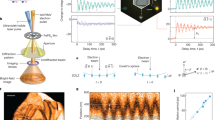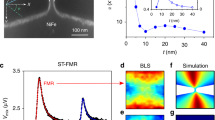Abstract
Ferromagnetic resonance is the most widely used technique for characterizing ferromagnetic materials1. However, its use is generally restricted to wafer-scale samples or specific micro-magnetic devices, such as spin valves, which have a spatially varying magnetization profile and where ferromagnetic resonance can be induced by an alternating current owing to angular momentum transfer2,3,4. Here we introduce a form of ferromagnetic resonance in which an electric current oscillating at microwave frequencies is used to create an effective magnetic field in the magnetic material being probed, which makes it possible to characterize individual nanoscale samples with uniform magnetization profiles. The technique takes advantage of the microscopic non-collinearity of individual electron spins arising from spin–orbit coupling and bulk or structural inversion asymmetry in the band structure of the sample5,6. We characterize lithographically patterned (Ga,Mn)As and (Ga,Mn)(As,P) nanoscale bars, including broadband measurements of resonant damping as a function of frequency, and measurements of anisotropy as a function of bar width and strain. In addition, vector magnetometry on the driving fields reveals contributions with the symmetry of both the Dresselhaus and Rashba spin–orbit interactions.
This is a preview of subscription content, access via your institution
Access options
Subscribe to this journal
Receive 12 print issues and online access
$259.00 per year
only $21.58 per issue
Buy this article
- Purchase on Springer Link
- Instant access to full article PDF
Prices may be subject to local taxes which are calculated during checkout




Similar content being viewed by others
References
Vonsovskıˇ, S. V. Ferromagnetic Resonance (Pergamon, 1966).
Tulapurkar, A. A. et al. Spin-torque diode effect in magnetic tunnel junctions. Nature 438, 339–342 (2005).
Sankey, J. C. et al. Spin-transfer-driven ferromagnetic resonance of individual nanomagnets. Phys. Rev. Lett. 96, 227601 (2006).
Myers, E. B., Ralph, D. C., Katine, J. A., Louie, R. N. & Buhrman, R. A. Current-induced switching of domains in magnetic multilayer devices. Science 285, 867–870 (1999).
Chernyshov, A. et al. Evidence for reversible control of magnetization in a ferromagnetic material by means of spin–orbit magnetic field. Nature Phys. 5, 656–659 (2009).
Miron, I. M. et al. Current-driven spin torque induced by the Rashba effect in a ferromagnetic metal layer. Nature Mater. 9, 230–234 (2010).
Aronov, A. G. & Lyanda-Geller, Y. B. Nuclear electric resonance and orientation of carrier spins by an electric field. JETP Lett. 50, 431 (1989).
Edelstein, V. Spin polarization of conduction electrons induced by electric current in two-dimensional asymmetric electron systems. Solid State Commun. 73, 233–235 (1990).
Inoue, J., Bauer, G. E. W. & Molenkamp, L. W. Diffuse transport and spin accumulation in a Rashba two-dimensional electron gas. Phys. Rev. B 67, 033104 (2003).
Silov, A. Y. et al. Current-induced spin polarization at a single heterojunction. Appl. Phys. Lett. 85, 5929–5931 (2004).
Manchon, A. & Zhang, S. Theory of spin torque due to spin–orbit coupling. Phys. Rev. B 79, 094422 (2009).
Garate, I. & MacDonald, A. H. Influence of a transport current on magnetic anisotropy in gyrotropic ferromagnets. Phys. Rev. B 88, 134403 (2009).
Costache, M. V., Watts, S. M., Sladkov, M., van der Wal, C. H. & van Wees, B. J. Large cone angle magnetization precession of an individual nanopatterned ferromagnet with dc electrical detection. Appl. Phys. Lett. 89, 232115 (2006).
Costache, M. V., Sladkov, M., van der Wal, C. H. & van Wees, B. J. On-chip detection of ferromagnetic resonance of a single submicron Permalloy strip. Appl. Phys. Lett. 89, 192506 (2006).
Goennenwein, S. T. B. et al. Electrically detected ferromagnetic resonance. Appl. Phys. Lett. 90, 162507 (2007).
Mecking, N., Gui, Y. S. & Hu, C-M. Microwave photovoltage and photoresistance effects in ferromagnetic microstrips. Phys. Rev. B 76, 224430 (2007).
Hui, X. et al. Electric detection of ferromagnetic resonance in single crystal iron film. Appl. Phys. Lett. 93, 232502 (2008).
Yamaguchi, A. et al. Broadband ferromagnetic resonance of Ni81Fe19 wires using a rectifying effect. Phys. Rev. B 78, 104401 (2008).
Silver, M., Batty, W., Ghiti, A. & O'Reilly, E. P. Strain-induced valence-subband splitting in III–V semiconductors. Phys. Rev. B 46, 6781 (1992).
Zemen, J., Kučera, J., Olejník, K. & Jungwirth, T. Magnetocrystalline anisotropies in (Ga,Mn)As: systematic theoretical study and comparison with experiment. Phys. Rev. B 80, 155203 (2009).
Rushforth, A. W. et al. Molecular beam epitaxy grown (Ga,Mn)(As,P) with perpendicular to plane magnetic easy axis. J. Appl. Phys. 104, 073908 (2008).
Hümpfner, S. et al. Lithographic engineering of anisotropies in (Ga,Mn)As. Appl. Phys. Lett. 90, 102102 (2007).
Wunderlich, J. et al. Local control of magnetocrystalline anisotropy in (Ga,Mn)As microdevices: demonstration in current-induced switching. Phys. Rev. B 76, 054424 (2007).
Wenisch, J. et al. Control of magnetic anisotropy in (Ga,Mn)As by lithography-induced strain relaxation. Phys. Rev. Lett. 99, 077201 (2007).
Hoffmann, F. et al. Mapping the magnetic anisotropy in (Ga,Mn)As nanostructures. Phys. Rev. B 80, 054417 (2009).
Khazen, K. et al. Anisotropic magnetization relaxation in ferromagnetic Ga1−xMnxAs thin films. Phys. Rev. B 78, 195210 (2008).
Liu, X. & Furdyna, J. K. Ferromagnetic resonance in Ga1−xMnxAs dilute magnetic semiconductors. J. Phys. Condens. Matter. 18, R245–R279 (2006).
Acknowledgements
The authors acknowledge fruitful discussions with I. Garate, A. H. MacDonald and L. Rokhinson and support from EU grants FP7-214499 NAMASTE, FP7-215368 SemiSpinNet, ERC Advanced Grant, from Czech Republic grants AV0Z10100521, KAN400100652, LC510, KJB100100802 and Praemium Academiae. D.F. acknowledges support from the Cambridge Overseas Trusts and Hitachi Cambridge Laboratory. A.J.F. acknowledges the support of a Hitachi research fellowship.
Author information
Authors and Affiliations
Contributions
D.F. and A.J.F. carried out device fabrication. D.F., H.K., J.W. and A.J.F. conducted experiments and carried out data analysis. K.V., L.P.Z. and T.J. developed the theory. R.P.C., A.C. and B.L.G. provided materials. D.F., A.J.F., T.J., L.P.Z., K.V., H.K. and J.W. all contributed to writing the manuscript. A.J.F. planned the project.
Corresponding author
Ethics declarations
Competing interests
The authors declare no competing financial interests.
Supplementary information
Supplementary information
Supplementary information (PDF 2310 kb)
Rights and permissions
About this article
Cite this article
Fang, D., Kurebayashi, H., Wunderlich, J. et al. Spin–orbit-driven ferromagnetic resonance. Nature Nanotech 6, 413–417 (2011). https://doi.org/10.1038/nnano.2011.68
Received:
Accepted:
Published:
Issue Date:
DOI: https://doi.org/10.1038/nnano.2011.68
This article is cited by
-
Field-free switching of perpendicular magnetization by two-dimensional PtTe2/WTe2 van der Waals heterostructures with high spin Hall conductivity
Nature Materials (2024)
-
Anomalous spin current anisotropy in a noncollinear antiferromagnet
Nature Communications (2023)
-
Impact of inherent energy barrier on spin-orbit torques in magnetic-metal/semimetal heterojunctions
Nature Communications (2023)
-
Observation of long-range orbital transport and giant orbital torque
Communications Physics (2023)
-
Magnetism, symmetry and spin transport in van der Waals layered systems
Nature Reviews Physics (2022)



